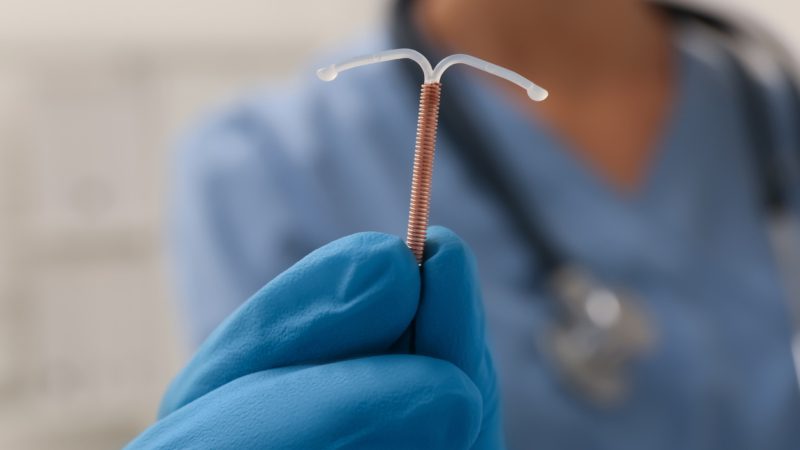A research team at the Keck School of Medicine conducts the first investigation of the safety of placing IUDs in women shortly after childbirth when chorioamnionitis is suspected.
By Hope Hamashige
Some women ask for a type of birth control called an intrauterine device, or IUD, after giving birth and before they leave the hospital. But if that woman developed an infection called chorioamnionitis, which infects the membranes around the fetus, doctors typically put off the placement for at least six weeks out of concern that the infection could worsen.
But a new study from the Keck School of Medicine of USC, which was published in the journal Contraception, found that placing an IUD after childbirth, even if there are signs of chorioamnionitis, might be safer than was previously believed. The research team pointed out that the protocol of deferring the placement of an IUD if chorioamnionitis is suspected is based on a theoretical concern that this could make the infection worse.
“The evidence for this guideline was never clearly established,” said Katherine Bayard, the study’s lead author and a medical student at the Keck School of Medicine. Bayard noted that the practice stems from research on sepsis, not chorioamnionitis. “There is good evidence that if there is sepsis, you cannot place an IUD, but they are extrapolating that the outcomes will be the same if chorioamnionitis is found. Our research shows that may not be the case.”
Few complications found
The researchers evaluated the medical records of 55 women who gave birth at LAC + USC Medical Center and wanted to have an IUD placed within a few days, and also were eventually suspected of having chorioamnionitis, an infection for which there is currently no rapid, bedside test. Of those, 22 had their IUDs placed before chorioamnionitis was suspected and 33 had their IUD placement deferred after a doctor suspected chorioamnionitis.
They were able to follow these 55 women through their medical records to determine if they later developed worsening infections or had other complications, such as abdominal pain. One year after giving birth, they found no statistically significant differences in infections or complications between the two groups of women and found no serious complications among either group.
“This doesn’t mean that giving women IUDs post-placentally when chorioamnionitis is suspected is absolutely safe,” said Bayard, noting that the sample size in the study is small. “This research was a solid first step to understanding how and when it is safe to give women IUDs after childbirth, but there needs to be more research with larger and more robust samples before we can consider changing our practice.”
Overdiagnosis leads to fewer IUD placements
While chorioamnionitis can be confirmed, doctors have to make treatment decisions in less time than it takes to turn around tests. The lack of an immediate test to confirm chorioamnionitis means doctors have to diagnose the infection based on a patients’ symptoms. However, doctors tend to over diagnose chorioamnionitis, said Bayard. Some doctors suspect pregnant women have chorioamnionitis if they develop a fever, even though there are many reasons for fever, and begin treating the suspected chorioamnionitis infection with antibiotics, she said.
To address concerns surrounding the over diagnosis of chorioamnionitis, a working group of the National Institute of Child Health and Human Development recommended in 2016 that doctors only begin treating pregnant women with antibiotics if they meet the criteria for intrauterine inflammation infection, or triple I. Triple I is defined as maternal fever with one or more of the following: a high fetal heart rate, a high maternal white blood cell count without steroid use or purulent cervical discharge.
The researchers found that if the doctors had applied the criteria for triple I, the outcomes for their patients would have been different. About half of the women in the study, 45.5%, did not meet the criteria for triple I which could have resulted in 18% more of the women receiving an IUD before leaving the hospital.
Doctors can place the IUD when the woman returns for a follow up appointment, which is typically scheduled around six weeks after childbirth. However, this practice leads to some women missing out on getting this form of birth control.
For a number of reasons, according to Bayard, women do not return for their six week follow up and then do not have a chance to get an IUD placed, noting that this is common among the women they treat at LAC+USC. When it can be done immediately after delivery, it increases the number of women who receive their desired choice of contraception.
“It such a great opportunity to be able to take the lead on this as a medical student,” said Bayard. “It was really amazing to contribute to a body of research that could one day change practice in the field, and to know I was contributing data on a largely unstudied area that has real impacts on the patients we serve.”
About the study
Additional authors of the study include Sonya P. Fabricant, Jessica White, Brian Gordon and Brian T. Nguyen of the Keck School of Medicine of USC.
